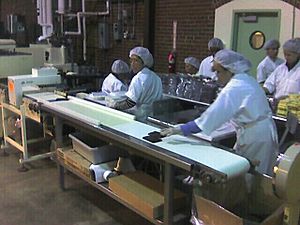Assembly line facts for kids
An assembly line is a special way of making things in factories. It's a very important part of how many products are made today.
On an assembly line, a product moves from one workstation to the next. At each stop, workers or machines add a specific part. This happens in a step-by-step order. Each person or machine does just one small job. This method makes products much faster than if one person made the whole item by hand.
The idea of splitting up work was talked about by Adam Smith in his book The Wealth of Nations in 1776. He used the example of making pins to show how doing one small task repeatedly can make things much more efficiently.
Henry Ford's Impact
The assembly line became very famous because of the Ford Motor Company. Between 1908 and 1915, Henry Ford and his team greatly improved how assembly lines worked. They used them for mass production, which means making many items quickly and cheaply.
This new way of working led to the Ford Model T car becoming much cheaper. Ford also paid his workers higher wages. Henry Ford was the first to master the moving assembly line. This helped him reduce the time it took to build a car. It also allowed his factories to make many more cars and parts. Ford was a leader in building huge factories designed around the assembly line idea.
Mass production using assembly lines changed the world. It made it possible for many people to buy manufactured goods because the cost of each item was low. Some say that Ford's system was clever because it made his own workers rich enough to buy his cars. Lower prices created a huge market for cars. This increased demand then allowed Ford to save even more money by making even more cars. This growth made Ford famous and set an example for other industries.
However, Henry Ford did not invent the assembly line. It was used in America before him, possibly starting with Ransom E. Olds making cars in 1901.
History of Assembly Lines
One of the earliest examples of an assembly system is the Terracotta Army from China. These ancient clay soldiers were made over 2,000 years ago, around the 3rd century BC.
The Terracotta Army figures were not made as one solid piece. Instead, they were created in workshops. The head, arms, legs, and torsos were made separately. Then, these parts were put together. Studies suggest that workers likely used eight different moulds (special shapes) for the faces. After the parts were assembled, details like facial expressions were added.
It is believed that the legs of the figures were made in a similar way to how clay drainage pipes were made back then. This shows it was an assembly line process. Specific parts were made and then put together after being baked in a hot oven. Each workshop had to write its name on the items it produced. Once finished, the terracotta figures were placed in pits in a precise military order, based on their rank and job.
Images for kids
-
An Airbus A321 being put together at the Airbus Hamburg-Finkenwerder plant.
-
Hyundai's car assembly line.
-
A Lotus Cars assembly line in 2008.
-
The pulley block was one of the first products to be made almost completely automatically. This happened at the Portsmouth Block Mills in the early 1800s.
-
In 1913, Ford experimented with putting the body onto the Model T chassis. They tried different ways to find the best method before setting up the equipment permanently. The actual assembly line used an overhead crane to lift the body.
See also
 In Spanish: Línea de ensamble para niños
In Spanish: Línea de ensamble para niños










